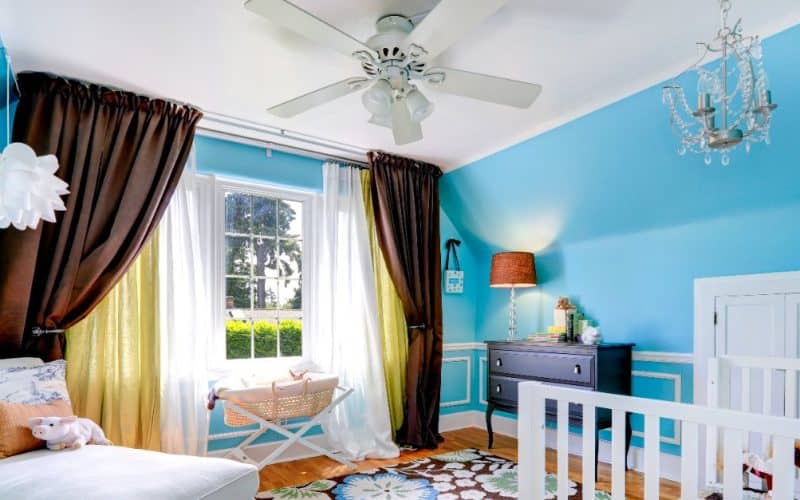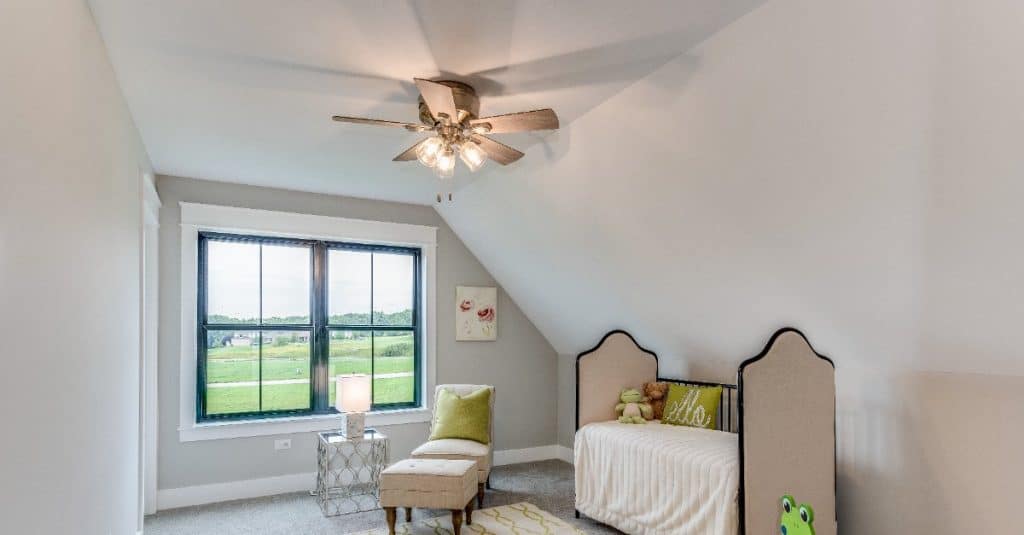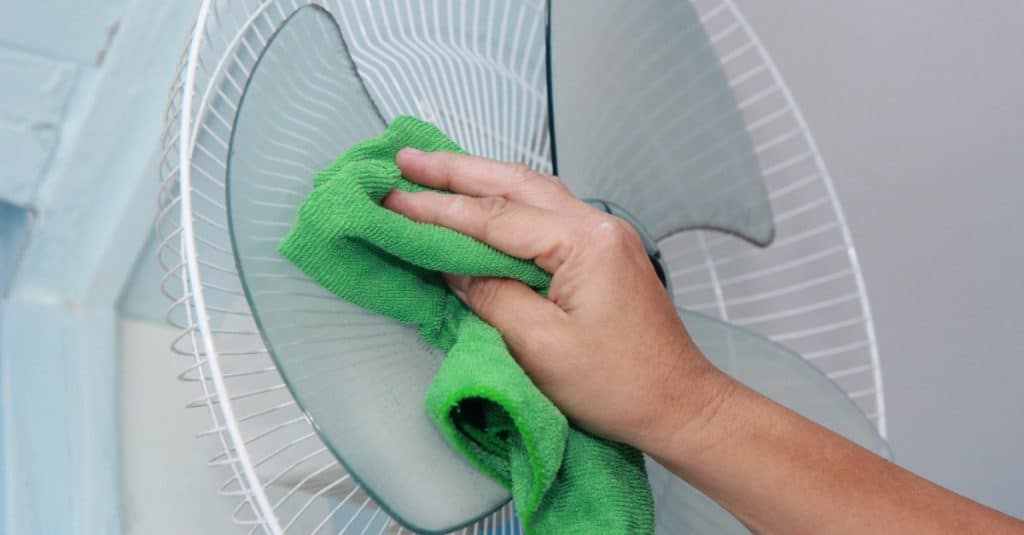A potentially overlooked part of nursery design by parents can be airflow and ventilation. Maintaining adequate room temperature for your newborn is very important, and airflow plays an important role in keeping your baby safe and comfortable. A ceiling fan can be an excellent way to maintain proper air circulation indoors, but can babies sleep with a ceiling fan on?
The answer is yes! According to an article published in the Archives of Pediatric & Adolescent Medicine, “fan use during sleep was associated with a 72% reduction in SIDS [Sudden Infant Death Syndrome] risk.”
The use of a fan reduced the incidence of newborn deaths, particularly when they slept in a warm room, when they were placed on the “side sleep position,” when they shared a bed with someone other than their parents, and when they slept without a pacifier.
Benefits of Sleeping with a Ceiling Fan On
1. Air Circulation
Ceiling fans can improve air quality in any room as they prevent carbon dioxide and pollutant build-up while contributing to oxygen flow. Depending on the time of year, your geographic location, and climate, you may consider opening or cracking a window open (when the air conditioning unit is not in use) to allow fresh outdoor air into the baby’s room.
Keep in mind, however, poor outdoor air quality may be unsafe for individuals with asthma or other respiratory conditions. Check with your local department of environmental quality to ensure the air quality in your area is safe before opening any windows in your home or your baby’s room.
Additionally, proper airflow in your baby’s nursery can prevent bacteria and viruses, particularly respiratory viruses, from accumulating. This is especially important during the holidays or any special gatherings where many visitors may be in attendance, as you may not know if they may be sick or simply not showing symptoms yet.
Having proper ventilation, especially for at least an hour after your visitors leave, can help keep your baby and your family safe from human pathogens.
2. Temperature Regulation
According to Grow by WebMD, the recommended room temperature for a baby is “between 68 and 72 degrees Fahrenheit.” Because babies’ bodies are still growing, they can be sensitive to changes in room temperature until they are about 11 weeks old, when their little bodies begin to self-regulate.
A ceiling fan can help keep the baby’s room temperature consistent throughout the night. To prevent your newborn from overheating, avoid over-bundling or bundling too tightly. And remember to never include blankets in their bed as they contribute to SIDS.
If you are concerned about your infant’s body temperature as they sleep, check the nape of their neck. If it’s sweaty, they are too hot. You can also check their chest and ears for overheating. Do not check their hands or feet as they usually run cold.
If your baby is too cold, their hands and feet will turn slightly blue, and they will be colder than usual to the touch.
As you become familiar with your newborn, you will figure out the correct ceiling fan setting for the optimal room temperature and the proper clothing, especially as the seasons change.
3. White Noise
Ceiling fans are an excellent way to provide soothing white noise for your baby. The continuous, relaxing sound may help your little one sleep soundly through the night as it muffles household noise as well as noise from neighbors, pets, and ground and air traffic.
The white noise produced by ceiling fans may also help babies fall asleep faster as research published in the Archives of Disease in Childhood found that 80% of babies “fell asleep within five minutes in response to white noise.”
4. Out of Baby’s Reach
An additional benefit of using a ceiling fan is that it will be out of reach of babies, especially when they start to crawl or walk. With a tower, free-standing, or tabletop fan, a baby or toddler could easily knock it over, leading to potentially serious injury as it falls on them.
Additionally, a ceiling fan’s blades would be out of reach of curious little fingers, preventing further injury.
Moreover, there would be no concern with cords or plugs with a ceiling fan, thus removing a strangulation and electrocution hazard.
Can Babies Sleep With a Ceiling Fan On? Things to Consider
1. Cleaning Your Ceiling Fan
Although ceiling fans can help with airflow and ventilation, they can also be dust and dirt magnets. Furthermore, it can be a little more complicated to clean ceiling fans since they are difficult to reach. Using a ladder or an extendable duster may help make things easier.
Take the proper precautions to avoid dust landing on your baby’s bedding, furniture, and toys. Using a damp cloth to clean the ceiling fan blades may be helpful.
Plan on cleaning your baby’s ceiling fan at least once a month. You may need to clean it more often if you open the windows regularly, to avoid causing respiratory issues or allergies to your little one.
Furthermore, avoid hanging anything, such as streamers, ropes, or balloons, from the ceiling fan’s blades as they can pose a serious risk of injury and could become tangled on the fan.
2. Monitor Baby’s Dryness
Babies’ skin can be very delicate. A ceiling fan has the potential to make the air in their room drier, leading your newborn to have a dry nose, eyes, and skin. If your baby has a skin condition, such as eczema, the dry air from the ceiling fan could exacerbate such a condition.
You can remedy this issue by placing a humidifier in your baby’s nursery. Always remember to use distilled water to avoid the development of bad odors, mold, and bacterial growth. Do clean your humidifier reservoir often.
3. Use a Remote Control
A technical aspect should be considered when choosing the right ceiling fan for your baby’s nursery. Since bright lights can be too harsh for a newborn’s eyes, you may want to choose a ceiling fan with dimmer capabilities.
Ceiling fans with dimmers usually come with a remote control that can also adjust the fan’s speed. Before making your selection, take note of whether the device makes a sound (typically a ‘beep’) when using it, as it may wake up your baby while they sleep.
If you already have a ceiling fan in the baby’s room and it does not have a remote dimmer, you may want to contemplate whether you want to do some rewiring to install a dimmer switch. A licensed electrician should be able to help.
Don’t want to install a wall dimmer switch? If you have a ceiling fan with multiple light bulbs, you may be able to remove one or two. However, that may create an eye sore. To avoid that, you may want to use light bulbs with lower wattage.
Although you will not be able to dim your lights up or down when you switch to lower-wattage bulbs, you will avoid the harsh lighting and protect your baby’s eyes.
To compensate for the dimmer lighting, you may want to include some strategically placed extra lamps around the room for additional lighting when needed.
4. Plan the Nursery’s Layout
When planning the layout of your baby’s nursery, be sure not to place the crib directly beneath the ceiling fan, as you want your baby to experience a gentle breeze from the fan. You will also want to avoid the highest setting since it may be too harsh for them.
Additionally, placing your baby directly beneath the ceiling fan can make them cold as the outside temperature drops during the night.
By not keeping the baby’s crib underneath the ceiling fan, you also prevent them from reaching for the ceiling fan cords when they begin to stand. Only keep the chords long enough for you to reach them, not your baby.
Final Thoughts
Although there are several things to consider before installing and choosing the right ceiling fan for your baby’s nursery, having one in their room has many benefits. From preventing SIDS to improving air circulation while removing pollutants and respiratory pathogens, to serving as a sleep aid and preventing injury, ceiling fans are a safe and healthy choice for your baby’s room.







